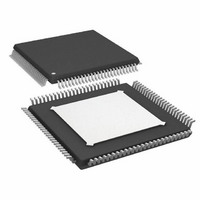AD9446BSVZ-100 Analog Devices Inc, AD9446BSVZ-100 Datasheet - Page 9

AD9446BSVZ-100
Manufacturer Part Number
AD9446BSVZ-100
Description
IC ADC 16BIT 100MSPS 100-TQFP
Manufacturer
Analog Devices Inc
Datasheet
1.AD9446BSVZ-100.pdf
(36 pages)
Specifications of AD9446BSVZ-100
Data Interface
Parallel
Number Of Bits
16
Sampling Rate (per Second)
100M
Number Of Converters
1
Power Dissipation (max)
2.8W
Voltage Supply Source
Single Supply
Operating Temperature
-40°C ~ 85°C
Mounting Type
Surface Mount
Package / Case
100-TQFP Exposed Pad
Resolution (bits)
16bit
Sampling Rate
100MSPS
Input Channel Type
Differential, Single Ended
Supply Voltage Range - Digital
3V To 3.6V
Supply Current
368mA
Number Of Elements
1
Resolution
16Bit
Architecture
Pipelined
Sample Rate
100MSPS
Input Polarity
Bipolar
Input Type
Voltage
Rated Input Volt
±1/±1.6V
Differential Input
Yes
Power Supply Requirement
Single
Single Supply Voltage (typ)
3.3/5V
Single Supply Voltage (min)
3.14/4.75V
Single Supply Voltage (max)
3.46/5.25V
Dual Supply Voltage (typ)
Not RequiredV
Dual Supply Voltage (min)
Not RequiredV
Dual Supply Voltage (max)
Not RequiredV
Power Dissipation
2.8W
Differential Linearity Error
±0.85LSB
Integral Nonlinearity Error
±6LSB
Operating Temp Range
-40C to 85C
Operating Temperature Classification
Industrial
Mounting
Surface Mount
Pin Count
100
Package Type
TQFP EP
Input Signal Type
Differential
Package
100TQFP EP
Number Of Analog Inputs
1
Digital Interface Type
Parallel
Signal To Noise Ratio
79.7(Typ) dB
Lead Free Status / RoHS Status
Lead free / RoHS Compliant
For Use With
AD9446-80LVDS/PCBZ - BOARD EVALUATION AD9446-80
Lead Free Status / Rohs Status
Compliant
Available stocks
Company
Part Number
Manufacturer
Quantity
Price
Company:
Part Number:
AD9446BSVZ-100
Manufacturer:
AD
Quantity:
138
Company:
Part Number:
AD9446BSVZ-100
Manufacturer:
ADI
Quantity:
132
Part Number:
AD9446BSVZ-100
Manufacturer:
ADI/亚德诺
Quantity:
20 000
TERMINOLOGY
Analog Bandwidth (Full Power Bandwidth)
The analog input frequency at which the spectral power of the
fundamental frequency (as determined by the FFT analysis) is
reduced by 3 dB.
Aperture Delay (t
The delay between the 50% point of the rising edge of the clock
and the instant at which the analog input is sampled.
Aperture Uncertainty (Jitter, t
The sample-to-sample variation in aperture delay.
Clock Pulse Width and Duty Cycle
Pulse width high is the minimum amount of time that the
clock pulse should be left in the Logic 1 state to achieve rated
performance. Pulse width low is the minimum time the clock
pulse should be left in the low state. At a given clock rate, these
specifications define an acceptable clock duty cycle.
Differential Nonlinearity (DNL, No Missing Codes)
An ideal ADC exhibits code transitions that are exactly 1 LSB
apart. DNL is the deviation from this ideal value. Guaranteed
no missing codes to 16-bit resolution indicates that all 65,536
codes must be present over all operating ranges.
Effective Number of Bits (ENOB)
The effective number of bits for a sine wave input at a given
input frequency can be calculated directly from its measured
SINAD using the following formula:
Gain Error
The first code transition should occur at an analog value of
½ LSB above negative full scale. The last transition should occur
at an analog value of 1½ LSB below the positive full scale. Gain
error is the deviation of the actual difference between first and
last code transitions and the ideal difference between first and
last code transitions.
Integral Nonlinearity (INL)
The deviation of each individual code from a line drawn from
negative full scale through positive full scale. The point used as
negative full scale occurs ½ LSB before the first code transition.
Positive full scale is defined as a level 1½ LSB beyond the last
code transition. The deviation is measured from the middle of
each particular code to the true straight line.
Maximum Conversion Rate
The clock rate at which parametric testing is performed.
ENOB
=
(
SINAD
A
)
6.02
−
1.76
)
J
)
Rev. 0 | Page 9 of 36
Minimum Conversion Rate
The clock rate at which the SNR of the lowest analog signal
frequency drops by no more than 3 dB below the guaranteed
limit.
Offset Error
The major carry transition should occur for an analog value of
½ LSB below VIN+ = VIN−. Offset error is defined as the
deviation of the actual transition from that point.
Out-of-Range Recovery Time
The time it takes for the ADC to reacquire the analog input
after a transition from 10% above positive full scale to 10%
above negative full scale, or from 10% below negative full scale
to 10% below positive full scale.
Output Propagation Delay (t
The delay between the clock rising edge and the time when all
bits are within valid logic levels.
Power-Supply Rejection Ratio
The change in full scale from the value with the supply at the
minimum limit to the value with the supply at the maximum
limit.
Signal-to-Noise and Distortion (SINAD)
The ratio of the rms input signal amplitude to the rms value of
the sum of all other spectral components below the Nyquist
frequency, including harmonics but excluding dc.
Signal-to-Noise Ratio (SNR)
The ratio of the rms input signal amplitude to the rms value of
the sum of all other spectral components below the Nyquist
frequency, excluding the first six harmonics and dc.
Spurious-Free Dynamic Range (SFDR)
The ratio of the rms signal amplitude to the rms value of the
peak spurious spectral component. The peak spurious component
may be a harmonic. SFDR can be reported in dBc (that is, degrades
as signal level is lowered) or dBFS (always related back to converter
full scale).
Temperature Drift
The temperature drift for offset error and gain error specifies
the maximum change from the initial (25°C) value to the value
at T
Total Harmonic Distortion (THD)
The ratio of the rms input signal amplitude to the rms value of
the sum of the first six harmonic components.
Two-Tone SFDR
The ratio of the rms value of either input tone to the rms value
of the peak spurious component. The peak spurious component
may or may not be an IMD product.
MIN
or T
MAX
.
PD
)
AD9446















